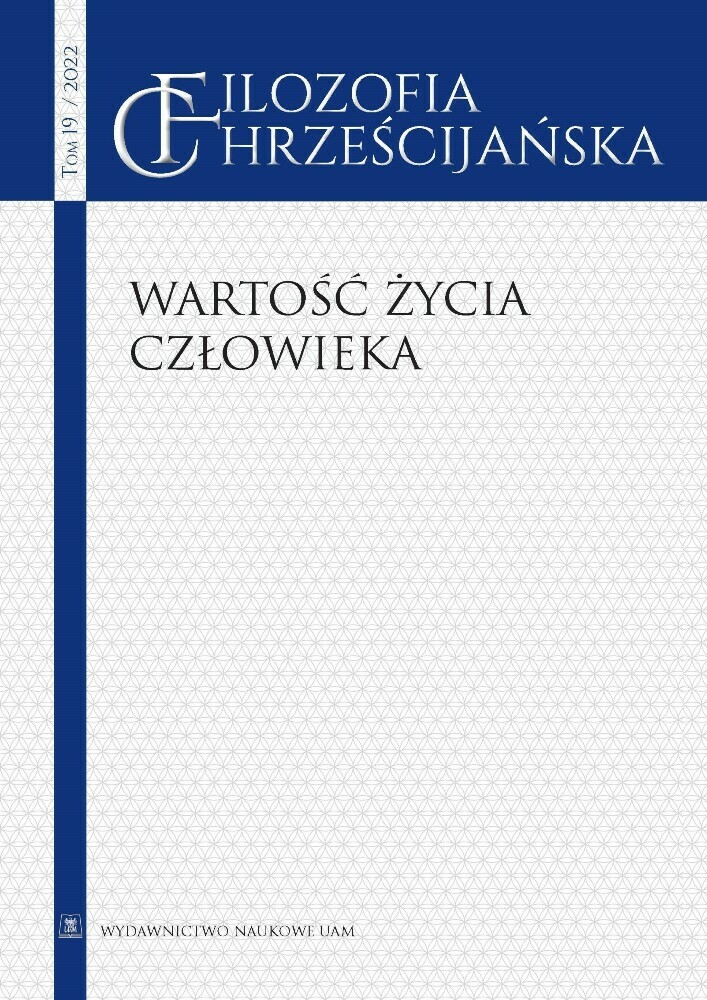Abstrakt
W dzisiejszych nihilistycznych czasach wartość życia często mierzy się użytecznością. Niniejszy artykuł rzuca wyzwanie takiemu podejściu, odwracając uwagę od tego, co jest nam dane, aby skupić się na tym, jak to otrzymujemy. Czerpiąc inspirację z teologicznej tradycji ikony, omawiam, jak możemy rozumieć to przesunięcie jako "przemianę spojrzenia". Wnikliwe studium aktu modlitwy przed ikoną ujawnia, jak możemy nabyć szczególny sposób patrzenia, co z kolei ma implikacje dla sposobu, w jaki rozumiemy życie.
Bibliografia
Andreopoulos A., Metamorphosis. The Transfiguration in Byzantine Theology and Iconography, Crestwood [USA: New York] 2005.
Balthasar H.U. von, Glory of the Lord, vol. 2: Studies in Theological Styles: Clerical Styles, trans. by A. Louth, F. McDonagh, B. McNeil, Edinburgh 1984.
Chrétien J.L., L’arche de la parole, Paris 1998.
Chrétien J.L., The Ark of Speech, trans. by A. Brown, London–New York 2004. https://doi.org/10.4324/9780203491034 DOI: https://doi.org/10.4324/9780203491034
Constas M., The Art of Seeing. Paradox and Perception in Orthodox Iconography, Los Angeles 2014.
Evdokimov P., The Art of the Icon: A Theology of Beauty, trans. by S. Bingham, California 1989.
Fernandez I., Création, in: Dictionnaire critique de la théologie, ed. J.Y. Lacoste, Paris 2007, p. 343-348.
Florensky P., Iconostasis, trans. by D. Sheehan, O. Andrejev, Crestwood [USA: New York] 1996.
Guscin M., Image of Edessa, Leiden 2009. https://doi.org/10.1163/ej.9789004171749.i-242 DOI: https://doi.org/10.1163/ej.9789004171749.i-242
Isaac the Syrian, The Ascetical Homilies of Saint Isaac the Syrian, Boston 2011.
John of Damascus, Homily for the Feast of the Transfiguration, in: Light on the Mountain. Greek Patristic and Byzantine Homilies on the Transfiguration of the Lord, trans. by B.E. Daley, S.J. Yonkers, New York 2013.
Julian of Norwich, Revelations of Divine Love, trans. by E. Spearing, London 1998.
Kearney R., The God Who May Be, Bloomington [USA: Illinois] 2001. https://doi.org/10.1163/ej.9789004171749.i-242 DOI: https://doi.org/10.2307/j.ctvz937hx.10
Kordis G., Icon as Communion, Brookline [USA: Massachusetts] 2011.
Kroug G., Carnets d’un peintre d’icônes, trans. by J.C. i V. Marcadé, Lausanne 2019.
Lacoste J.Y., Experience and the Absolute. Disputed Questions on the Humanity of Man, trans. by M. Rafferty, New York 2004.
Lacoste J.Y., Expérience et Absolu. Questions disputées sur l’humanité de l’homme, Paris 1989.
Lacoste J.Y., Half-Objections and Remarks, „Scottish Episcopal Institute Journal” 3.3 (Autumn 2019), p. 26.
Lacoste J.Y., The Phenomenality of Anticipation, in: Phenomenology and Eschatology. Not Yet in the Now, ed. N. DeRoo, J.P. Manoussakis, trans. by R. Mendoza-De Jesús, N. DeRoo, New York 2009.
Lidov A., Hierotropy. The Creation of Sacred Spaces as a Form of Creativity and Subject of Cultural History, in: Hierotropy. The Creation of Sacred Spaces in Byzantium and Medieval Russia, ed. A. Lidov, Moscow 2006, p. 32-58.
Louth A., St. John Damascene. Tradition and Originality in Byzantine Theology, Oxford 2002. https://doi.org/10.1093/0199252386.001.0001 DOI: https://doi.org/10.1093/0199252386.001.0001
Marion J.L., Au lieu de soi. L’approche de Saint Augustin, Paris 2008. https://doi.org/10.3917/puf.mario.2008.01 DOI: https://doi.org/10.3917/puf.mario.2008.01
Marion J.L., Being Given: Towards a Phenomenology of Givenness, trans. by J.L. Kosky, Stanford 2002.
Marion J.L., Believing in Order to See. On the Rationality of Revelation and the Irrationality of Some Believers, trans. by Ch.M. Gschwandtner, New York 2017. https://doi.org/10.5422/fordham/9780823275847.001.0001 DOI: https://doi.org/10.5422/fordham/9780823275847.001.0001
Marion J.L., Certitudes négatives, Paris 2010.
Marion J.L., De surcroît. Études sur les phénomènes saturés, Paris 2001.
Marion J.L., Étant donné. Essai d’une phénoménologie de la donation, Paris 1997.
Marion J.L., In Excess. Studies of Saturated Phenomena, trans. by R. Horner, V. Berraud, New York 2002.
Marion J.L., In the Self’s Place: The Approach of Saint Augustine, trans. by J.L. Kosky, Stanford 2012.
Marion J.L., Le croire pour le voir, Paris 2010.
Marion J.L., L’idole et la distance, Paris 1977.
Marion J.L., Negative Certainties, Chicago 2015. https://doi.org/10.7208/chicago/9780226807102.001.0001 DOI: https://doi.org/10.7208/chicago/9780226807102.001.0001
Marion J.L., Seeing, or Seeing Oneself Seen: Nicholas of Cusa’s Contribution in «De visione Dei», trans. by S.E. Lewis, „The Journal of Religion” 96, no. 3 (July 2016), p. 305-331. https://doi.org/10.1086/686566 DOI: https://doi.org/10.1086/686566
Marion J.L., The Idol and Distance. Five Studies, trans. by Th.A. Carlson, New York 2001.
Marion J.L., Voir, se voir vu voyant: L’apport de Nicolas de Cues dans le «De visione Dei», „Bulletin de littérature ecclésiastique” 117, no. 2 (2016), p. 7-37.
Ouspensky L., Lossky V., The Meaning of Icons, trans. by G.E.H. Palmer, E. Kadloubovsky, Crestwood [USA: New York] 1952.
Ouspensky L., Theology of the Icon, t. 1-2, trans. by A.G. Crestwood, New York 1992.
Patrologia Cursus Completus, Series Graeca, t. 1-161, ed. J.P. Migne, Paris 1857-1866.
Rumpza S., Phenomenology of the Icon: Mediating God in his Image, Cambridge 2023.
Sendler E., Les mystères du Christ: les icônes de la liturgie, Paris 2001.
Seraphim of Sarov, Motovilov N.. The Aim of Christian Life: St. Seraphim of Sarov’s Conversation With Nicholas Motovilov, trans. by J. Phillips, Cambridge 2010.
Tsakiridou C.A., Icons in Time, Persons in Eternity: Orthodox Theology and the Aesthetics of the Christian Image, Burlington [USA: Vermont] 2013.
Westphal M., Transfiguration as Saturated Phenomenon, „Journal of Philosophy and Scripture” 1:1 (2003), p. 26-35.
Licencja
Prawa autorskie (c) 2022 Stephanie Rumpza

Utwór dostępny jest na licencji Creative Commons Uznanie autorstwa – Bez utworów zależnych 4.0 Międzynarodowe.
Autorzy
Autorzy tekstów przyjętych do publikacji w czasopiśmie Filozofia Chrześcijańska są zobowiązani do wypełnienia, podpisania i odesłania na adres redakcji umowy o udzielenie nieodpłatnej licencji do utworów, z zobowiązaniem do udzielania sublicencji CC.
Zgodnie z umową, autorzy tekstów opublikowanych w czasopiśmie Filozofia Chrześcijańska udzielają Uniwersytetowi im. Adama Mickiewicza w Poznaniu niewyłącznej i nieodpłatnej licencji oraz zezwalą na użycie sublicencji Creative Commons Attribution-NoDerivatives 4.0 International (CC BY-ND 4.0).
Autorzy zachowują prawa do dalszego, swobodnego rozporządzania utworem.
Użytkownicy
Zainteresowani użytkownicy internetu uprawnieni są do korzystania z utworów opublikowanych od 2015 roku w Filozofia Chrześcijańska pod następującymi warunkami:
- uznanie autorstwa - obowiązek podania wraz z rozpowszechnionym utworem, informacji, o autorstwie, tytule, źródle (odnośniki do oryginalnego utworu, DOI) oraz samej licencji;
- bez tworzenia utworów zależnych - utwór musi być zachowany w oryginalnej postaci, nie można bez zgody twórcy rozpowszechniać np. tłumaczeń, opracowań.
Do wszystkich tekstów opublikowanych przed 2015 r. prawa autorskie są zastrzeżone.
Inne
Uniwersytet im. Adama Mickiewicza w Poznaniu zachowuje prawo do czasopisma jako całości (układ, forma graficzna, tytuł, projekt okładki, logo itp.).

